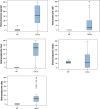Systematic analysis and validation of differential gene expression in ovarian serous adenocarcinomas and normal ovary
- PMID: 23090696
- PMCID: PMC11824236
- DOI: 10.1007/s00432-012-1334-8
Systematic analysis and validation of differential gene expression in ovarian serous adenocarcinomas and normal ovary
Abstract
Purpose: Cancer of the ovary confers the worst prognosis among women with gynecological malignancies, primarily because most ovarian cancers are diagnosed at late stage. Hence, there is a substantial need to develop new diagnostic biomarkers to enable detection of ovarian cancer at earlier stages, which would confer better prognosis. In addition, the identification of druggable targets is of substantial interest to find new therapeutic strategies for ovarian cancer.
Methods: The expression of 22,500 genes in a series of 67 serous papillary carcinomas was compared with 9 crudely enriched normal ovarian tissue samples by RNA hybridization on oligonucleotide microarrays. Multiple genes with near-uniformly expression were elevated in carcinomas of varying grade and malignant potential, including several previously described genes (e.g., MUC-1, CD9, CD24, claudin 3, and mesothelin). We performed immunohistochemical staining with antibodies against several of the proteins encoded by differentially expressed genes in an independent cohort of 71 cases of paraffin-embedded ovarian cancer samples.
Results: We found striking differences in EpCAM (p < 0.005), CD9 (p < 0.001), MUC-1 (p < 0.001), and claudin 3 proteins (p < 0.001) but not for mesothelin (p > 0.05) using the Mann-Whitney U test.
Conclusions: Protein expression of a majority of the differentially expressed genes tested was found to be elevated in ovarian carcinomas and, as such, define potential new biomarkers or targets.
Conflict of interest statement
The authors declare that they have no conflict of interest.
Figures




Similar articles
-
Intraoperative frozen section analysis for the diagnosis of early stage ovarian cancer in suspicious pelvic masses.Cochrane Database Syst Rev. 2016 Mar 1;3(3):CD010360. doi: 10.1002/14651858.CD010360.pub2. Cochrane Database Syst Rev. 2016. PMID: 26930463 Free PMC article.
-
Impact of residual disease as a prognostic factor for survival in women with advanced epithelial ovarian cancer after primary surgery.Cochrane Database Syst Rev. 2022 Sep 26;9(9):CD015048. doi: 10.1002/14651858.CD015048.pub2. Cochrane Database Syst Rev. 2022. PMID: 36161421 Free PMC article.
-
A rapid and systematic review of the clinical effectiveness and cost-effectiveness of paclitaxel, docetaxel, gemcitabine and vinorelbine in non-small-cell lung cancer.Health Technol Assess. 2001;5(32):1-195. doi: 10.3310/hta5320. Health Technol Assess. 2001. PMID: 12065068
-
Challenging Salpingectomy as a Risk-Reducing Measure for Ovarian Cancer: Histopathological Analysis of the Tubo-Ovarian Interface in Women Undergoing Risk-Reducing Salpingo-oophorectomy.Int J Gynecol Cancer. 2017 May;27(4):703-707. doi: 10.1097/IGC.0000000000000954. Int J Gynecol Cancer. 2017. PMID: 28399030
-
Taxane monotherapy regimens for the treatment of recurrent epithelial ovarian cancer.Cochrane Database Syst Rev. 2022 Jul 12;7(7):CD008766. doi: 10.1002/14651858.CD008766.pub3. Cochrane Database Syst Rev. 2022. PMID: 35866378 Free PMC article.
Cited by
-
Functional genomic mRNA profiling of a large cancer data base demonstrates mesothelin overexpression in a broad range of tumor types.Oncotarget. 2015 Sep 29;6(29):28164-72. doi: 10.18632/oncotarget.4461. Oncotarget. 2015. PMID: 26172299 Free PMC article.
-
Prevalence of DLL3, CTLA-4 and MSTN Expression in Patients with Small Cell Lung Cancer.Onco Targets Ther. 2019 Nov 21;12:10043-10055. doi: 10.2147/OTT.S216362. eCollection 2019. Onco Targets Ther. 2019. PMID: 31819500 Free PMC article.
References
-
- Auersperg N (2011) The origin of ovarian carcinomas: a unifying hypothesis. Int J Gynecol Pathol 30(1):12–21 - PubMed
-
- Bast RC Jr (2003) Status of tumor markers in ovarian cancer screening. J Clin Oncol 21(10 Suppl):200s–205s - PubMed
-
- Bauerschlag DO, Ammerpohl O et al (2011) Progression-free survival in ovarian cancer is reflected in epigenetic DNA methylation profiles. Oncology 80(1–2):12–20 - PubMed
-
- Brakora KA, Lee H et al (2004) Utility of osteopontin as a biomarker in recurrent epithelial ovarian cancer. Gynecol Oncol 93(2):361–365 - PubMed
Publication types
MeSH terms
Grants and funding
LinkOut - more resources
Full Text Sources
Medical
Research Materials
Miscellaneous

